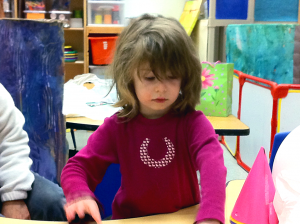The following is an article I was forwarded about the SFUSD Teachers that are planning a strike. Most of the news seems to focus on teachers wanting a pay increase, but aren’t looking at the full effects of what will happen. I have bolded and italicized a particular section because as many of you know my autistic daughter is in a SDC or Special Day Class. When she started there were only about 8 kids in the class [this was for pre-school] when she starts kindergarten in the fall there will be 12 kids in the class. The increases they want are unthinkable for special needs kids let alone non-special needs kids.
My daughter’s current pre-school teacher had her students raised to 12 this year and it was maddening for her at times. She did not have enough materials or aides to help her out and was only given a funding of $5/student for the entire school year. I am reposting this because sometimes teachers need to put their foot down. These aren’t teachers in the six figure range, but teachers who are lucky to get $50k/year and they’re investing their own money in purchasing school supplies because the SFUSD isn’t providing them enough to use to teach their classes.
Members of United Educators of San Francisco on the march
UNITED EDUCATORS of San Francisco (UESF) is mobilizing for the first of two strike votes on May 10. The union was pushed to organize a membership meeting because of a massive assault on educators and public schools.
The San Francisco Unified School District (SFUSD) opened contract negotiations by sending out over 500 layoff notices. It tried to split the union by attacking seniority, and then proceeded to demand even larger concessions by, for example, asking to raise class size in K-3 from 22 to 25 stuents.
We already rank highest in the number of K-12 students per teacher, with an estimated 20.5 students per teacher–the rest of the country averages 13.8, according to the California Budget Project. This will make things worse for students and educators trying to work in an already underfunded system.
Not content with raising class size in the early primary grades, SFUSD is also proposing to increase special day class limits from 12 to 17. Special day classes serve students who, because of a disability, can’t function in a standard classroom.
They also want to remove many of the protections for special education teachers to get help from the principal in case of an emergency and limit the ability of regular classroom teachers to give input about students with high needs. Finally, the district wishes to remove the teacher position from a committee that makes decisions about special education.
As Matt Bello, a special day class teacher, noted, “The district is trying to convince us that the proposed special education reforms will be a step forward. How could increased caseloads and class sizes along with the removal of teacher input in district decision making be looked at as progress?”
SFUSD is also asking educators to cover the same material in fewer days by proposing eight furlough days over the next two years if Gov. Jerry Brown’s tax measure passes. If the tax measure doesn’t pass, they want to increase that number to 18 furlough days.
For early childhood education centers, the attack is even more brutal. Regardless of what happens in November’s’ election, 27 days are to be cut from each year. Students at their youngest will be denied some of the basic educational foundations that could help make them successful and ready for kindergarten.
In addition to affecting students, these cuts will bring a huge cost to educators. For paraprofessionals, in particular, the cuts to early childhood education will cost thousands of dollars and take away valuable jobs during the summer when paraprofessionals are unemployed.
Further, the district is going to unilaterally change all of the paraprofessional hours to standardize them at 5.5 hours each day. This is disastrous, as right now, they don’t make a living wage. It means that many will have to give up their second job, while many will also have to scale back their hours. Even worse, these decisions won’t be based on fulfilling students’ needs at a particular school, but rather to meet an arbitrary time requirement.
As Robin Horne, a paraprofessional at Marina Middle School, summed up:
The attacks on paraprofessionals will be devastating to us. We barely make enough money to survive in this city, and we are unemployed during the summer. Many of us are also losing hours, which is a partial layoff. Others will be forced to take on more hours, which will prevent some from holding down a second job. Still other paraprofessionals will be losing their jobs outright.
Paraprofessionals often have a stronger connection to working class communities in San Francisco than teachers, as they are more likely to be San Francisco natives from working class areas in this city. Losing these people will not only be devastating for them, but will also be an attack on working people in San Francisco in general.
Financially, we are looking at a cut in compensation of $10,391 for certificated staff (teachers, psychologists, social workers, nurses and counselors) and up to $3,206 for classified staff (special education assistants, instructional aides, community relations). Substitutes will lose up to $6,983. Those hit the hardest will be early education teachers, who stand to lose $16,307 in compensation.
By any standard, this is the largest attack on our union in the last 20 years. It’s clear that the district is making a major push toward school “reform” at the expense of teachers, students, and communities these schools serve.
To accomplish its goals, SFUSD will stoop to any level, pitting educators against each other by using social justice language as they did around seniority. They are willing to break the law by throwing out whole sections of the contract around special education. It is obvious that they are also going to sidestep collective bargaining, because on May 3, the SFUSD declared an impasse, moving one step closer to imposing these cuts unilaterally.
The district feels confident about pushing its agenda now partially because the union has given into concessions before. Two years ago, UESF took a contract that gave back $39 million during the deepest point of the economic crisis. Most of the money came from eight furlough days and layoffs.
Unfortunately, the union has shown that it is more than willing to share the sacrifice during a recession. However, the district now has enough in reserve to save people’s jobs. It isn’t a question of money; now, it’s a question of will and intention.
To fight against cuts, UESF has taken halting steps towards organizing the membership. It was clear from the start of bargaining that the district was going after a lot. Yet the current leadership hesitated for months in calling for a strike vote.
They continued to rely on their “skills” at the negotiation table to try to beat back the attack long after it became clear that SFUSD was not giving in. The membership was asked to trust that the bargaining team was doing the right thing and to wait until our activity was needed.
Unfortunately, our union leadership seems to be more afraid of active membership than SFUSD. For two months, at each bargaining session, UESF was asked for more and more. Yet the leadership was unclear about organizing for a strike vote until after the April 24 bargaining session.
Now that they are backed into a corner, they finally organized a strike vote for May 10. They are scrambling to make the membership meeting successful–we must have at least 900 people at it for a quorum. We have lost valuable time in preparations.
 Just a quick message to let you all know if you’re looking for something to do today that Sunset Elementary will be holding their Sunset Spring Festival at 40th and Ortega. Doors open at noon and there will be lots of games, things to see, people to meet and of course food.
Just a quick message to let you all know if you’re looking for something to do today that Sunset Elementary will be holding their Sunset Spring Festival at 40th and Ortega. Doors open at noon and there will be lots of games, things to see, people to meet and of course food.










